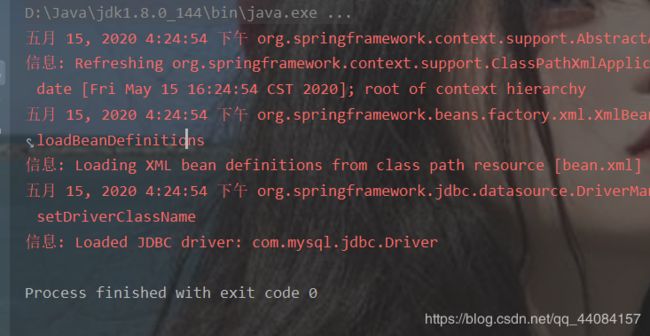spring中的JdbcTemplate---day04_01
JdbcTemplate的作用:
他就是用于和数据库交互的,实现对表的ceud操作
如何创建该对象·:
对象中的常用方法
我们来看看它最基本的使用:
先创建一个maven工程
在Java下新建包,在com.itheima.domain下新建一个Account实体类:
package com.itheima.domain;
import java.io.Serializable;
public class Account implements Serializable {
private Integer id;
private String name;
private Float money;
public Integer getId() {
return id;
}
public void setId(Integer id) {
this.id = id;
}
public String getName() {
return name;
}
public void setName(String name) {
this.name = name;
}
public Float getMoney() {
return money;
}
public void setMoney(Float money) {
this.money = money;
}
@Override
public String toString() {
return "Account{" +
"id=" + id +
", name='" + name + '\'' +
", money=" + money +
'}';
}
}
之后再新建一个JdbcTemplate包,在包下新建一个JdbcTemplate类,在里面我们运用它最基本的用法:
package com.itheima.kdbctemplate;
import org.springframework.jdbc.core.JdbcTemplate;
import org.springframework.jdbc.datasource.DriverManagerDataSource;
/**
* JdbcTemplate的最基本用法
*/
public class JdbcTemplateDemo1 {
public static void main(String[] args) {
//准备数据源,这里用spring的内置数据源
DriverManagerDataSource ds = new DriverManagerDataSource();
ds.setDriverClassName("com.mysql.jdbc.Driver");
ds.setUrl("jdbc:mysql://localhost:3306/eesy");
ds.setUsername("root");
ds.setPassword("18205071");
//1.1,创建JdbcTemplate对象
JdbcTemplate jt = new JdbcTemplate();
//1.2给jt设置数据源
jt.setDataSource(ds);
//2,执行操作
jt.execute("insert into account(name,money)values ('ccc',1000)");
}
}
运行结果:

可以看到它的基本使用是很简单的,但是我们可以看到我们把数据源写死了,我们还可以看到new的几个对象我们可以进行配置。
那么我们就需要在配置文件下新建一个bean.xml,并且在里面配置好数据源
bean
<?xml version="1.0" encoding="UTF-8"?>
<beans xmlns="http://www.springframework.org/schema/beans"
xmlns:xsi="http://www.w3.org/2001/XMLSchema-instance"
xsi:schemaLocation="http://www.springframework.org/schema/beans
http://www.springframework.org/schema/beans/spring-beans.xsd">
<!--配置JdbcTemplate-->
<bean id="jdbcTemplate" class="org.springframework.jdbc.core.JdbcTemplate">
<property name="dataSource" ref="dataSource"></property>
</bean>
<!--配置数据源-->
<bean id="dataSource" class="org.springframework.jdbc.datasource.DriverManagerDataSource">
<property name="driverClassName" value="com.mysql.jdbc.Driver"></property>
<property name="url" value="jdbc:mysql://localhost:3306/eesy"></property>
<property name="username" value="root"></property>
<property name="password" value="18205071"></property>
</bean>
</beans>
之后我们在jdbcTemplate包下再新建一个JdbcTemplate2类
在里面实现用配置的方式获取数据源执行代码:
package com.itheima.jdbctemplate;
import org.springframework.context.ApplicationContext;
import org.springframework.context.support.ClassPathXmlApplicationContext;
import org.springframework.jdbc.core.JdbcTemplate;
import org.springframework.jdbc.datasource.DriverManagerDataSource;
/**
* JdbcTemplate的最基本用法
*/
public class JdbcTemplateDemo2 {
public static void main(String[] args) {
// //准备数据源,这里用spring的内置数据源
// DriverManagerDataSource ds = new DriverManagerDataSource();
// ds.setDriverClassName("com.mysql.jdbc.Driver");
// ds.setUrl("jdbc:mysql://localhost:3306/eesy");
// ds.setUsername("root");
// ds.setPassword("18205071");
// //1.1,创建JdbcTemplate对象
// JdbcTemplate jt = new JdbcTemplate();
// //1.2给jt设置数据源
// jt.setDataSource(ds);
// //2,执行操作
// jt.execute("insert into account(name,money)values ('cc',1000)");
//获取容器
ApplicationContext ac =new ClassPathXmlApplicationContext("bean.xml");
//获取对象
JdbcTemplate jd = ac.getBean("jdbcTemplate",JdbcTemplate.class);
//执行操作
jd.execute("insert into account(name,money)values ('cccc',1000)");
}
}
我们可以看到运行结果,及数据库没有什么问题
package com.itheima.jdbctemplate;
import com.itheima.domain.Account;
import com.sun.corba.se.spi.resolver.LocalResolver;
import org.springframework.context.ApplicationContext;
import org.springframework.context.support.ClassPathXmlApplicationContext;
import org.springframework.jdbc.core.BeanPropertyRowMapper;
import org.springframework.jdbc.core.JdbcTemplate;
import org.springframework.jdbc.core.RowMapper;
import java.sql.ResultSet;
import java.sql.SQLException;
import java.util.List;
/**
* JdbcTemplate的最基本用法
*/
public class JdbcTemplateDemo3 {
public static void main(String[] args) {
//获取容器
ApplicationContext ac =new ClassPathXmlApplicationContext("bean.xml");
//获取对象
JdbcTemplate jd = ac.getBean("jdbcTemplate",JdbcTemplate.class);
//执行操作
//jd.execute("insert into account(name,money)values ('cccc',1000)");
//保存
// jd.update("insert into account(name,money)values (?,?)","eee",3333f);
//更新
// jd.update("update account set name = ?,money = ? where id = ?","test",4567,7);
//删除
jd.update("delete from account where id = ?",6);
//查询所有
// List accounts = jd.query("select * from account where money >?",new AccountRowMapper(),1000f );
// List accounts = jd.query("select * from account where money >?",new BeanPropertyRowMapper(Account.class),1000f );
// for (Account account : accounts){
// System.out.println(account);
// }
//查询一个
List<Account> accounts = jd.query("select * from account where id = ?",new BeanPropertyRowMapper<Account>(Account.class),1 );
System.out.println(accounts.isEmpty()?"没有内容":accounts.get(0));
//查询返回一行一列
Long count = jd.queryForObject("select count(*) from account where money > ?",Long.class,1000f);
System.out.println(count);
}
}
/**
* 定义Account的封装策略
*/
class AccountRowMapper implements RowMapper<Account> {
public Account mapRow(ResultSet rs, int rowNum) throws SQLException {
Account account = new Account();
account.setId(rs.getInt("id"));
account.setName(rs.getString("name"));
account.setMoney(rs.getFloat("money"));
return account;
}
}
当然我们在实际开发中是不这样写的,我们会在itheima包下新建一个dao包,在这下面新建接口和类编写代码:
IAccountDao接口
package com.itheima.dao;
import com.itheima.domain.Account;
/**
* 账户的持久层接口
*/
public interface IAccountDao {
/**
* 根据id查询账户
* @return
*/
Account findAccountById(Integer integer);
/**
* 根据名称查询账户
* @return
*/
Account findAccountByName(String accountName);
/**
* 更新账户
* @param account
*/
void updateAccount(Account account);
}
AccountDaoImpl实现类
package com.itheima.dao.impl;
import com.itheima.dao.IAccountDao;
import com.itheima.domain.Account;
import org.springframework.jdbc.core.BeanPropertyRowMapper;
import org.springframework.jdbc.core.JdbcTemplate;
import java.util.List;
/**
* 账户的持久层实现类
*/
public class AccountDaoImpl implements IAccountDao {
private JdbcTemplate jdbcTemplate;
public void setJdbcTemplate(JdbcTemplate jdbcTemplate) {
this.jdbcTemplate = jdbcTemplate;
}
public Account findAccountById(Integer accountId) {
List<Account> accounts = jdbcTemplate.query("select * from account where id = ?",new BeanPropertyRowMapper<Account>(Account.class),accountId);
return accounts.isEmpty()?null:accounts.get(0);
}
public Account findAccountByName(String accountName) {
List<Account> accounts = jdbcTemplate.query("select * from account where name = ?",new BeanPropertyRowMapper<Account>(Account.class),accountName);
if (accounts.isEmpty()){
return null;
}
if (accounts.size()>1){
throw new RuntimeException("结果集不唯一");
}
return accounts.get(0);
}
public void updateAccount(Account account) {
jdbcTemplate.update("update account set name =?,money = ? where id = ?",account.getName(),account.getMoney(),account.getId());
}
}
我们来编写一下测试:
dbcTemplateDemo4
package com.itheima.jdbctemplate;
import com.itheima.dao.IAccountDao;
import com.itheima.domain.Account;
import org.springframework.context.ApplicationContext;
import org.springframework.context.support.ClassPathXmlApplicationContext;
import org.springframework.jdbc.core.JdbcTemplate;
/**
* JdbcTemplate的最基本用法
*/
public class JdbcTemplateDemo4 {
public static void main(String[] args) {
//获取容器
ApplicationContext ac =new ClassPathXmlApplicationContext("bean.xml");
IAccountDao accountDao = ac.getBean("accountDao",IAccountDao.class);
Account account = accountDao.findAccountById(1);
System.out.println(account);
}
}
之后我们来看个代码:

假如有多个实现类,这里就会出现多个重复性代码,那我们可以怎样修改呢,我们先cope一个AccountDaoImpl,改成AccountDaoImpl2,之后在Impl包下写一个类:JdbcDaoSupport,那么我们就可以让我们的dao实现类继承这个JdbcDaoSupport类
package com.itheima.dao.impl;
import org.springframework.jdbc.core.JdbcTemplate;
/**
* 此类用于抽取dao中的重复性代码
*/
public class JdbcDaoSupport {
private JdbcTemplate jdbcTemplate;
public void setJdbcTemplate(JdbcTemplate jdbcTemplate) {
this.jdbcTemplate = jdbcTemplate;
}
public JdbcTemplate getJdbcTemplate() {
return jdbcTemplate;
}
}
之后我们修改一下·AccountDaoImpl:
package com.itheima.dao.impl;
import com.itheima.dao.IAccountDao;
import com.itheima.domain.Account;
import org.springframework.jdbc.core.BeanPropertyRowMapper;
import org.springframework.jdbc.core.JdbcTemplate;
import java.util.List;
/**
* 账户的持久层实现类
*/
public class AccountDaoImpl extends JdbcDaoSupport implements IAccountDao {
public Account findAccountById(Integer accountId) {
List<Account> accounts = super.getJdbcTemplate().query("select * from account where id = ?",new BeanPropertyRowMapper<Account>(Account.class),accountId);
return accounts.isEmpty()?null:accounts.get(0);
}
public Account findAccountByName(String accountName) {
List<Account> accounts = super.getJdbcTemplate().query("select * from account where name = ?",new BeanPropertyRowMapper<Account>(Account.class),accountName);
if (accounts.isEmpty()){
return null;
}
if (accounts.size()>1){
throw new RuntimeException("结果集不唯一");
}
return accounts.get(0);
}
public void updateAccount(Account account) {
super.getJdbcTemplate().update("update account set name =?,money = ? where id = ?",account.getName(),account.getMoney(),account.getId());
}
}
可以看到我们之前的JdbcTemplate被换成了getJdbcTemplate(),这样我们就减少了重复性代码的出现。
那除了JdbcTemplate我们可以修改外,我们还可以在JdbcDaoSupport里修改DataSource:
package com.itheima.dao.impl;
import org.springframework.jdbc.core.JdbcTemplate;
import javax.sql.DataSource;
/**
* 此类用于抽取dao中的重复性代码
*/
public class JdbcDaoSupport {
private JdbcTemplate jdbcTemplate;
public void setJdbcTemplate(JdbcTemplate jdbcTemplate) {
this.jdbcTemplate = jdbcTemplate;
}
public JdbcTemplate getJdbcTemplate() {
return jdbcTemplate;
}
public void setDataSource(DataSource dataSource){
if (jdbcTemplate == null){
jdbcTemplate = createJdbcTemplate(dataSource);
}
}
public JdbcTemplate createJdbcTemplate(DataSource dataSource){
return new JdbcTemplate(dataSource);
}
}
之后我们去修改bean.xml
<?xml version="1.0" encoding="UTF-8"?>
<beans xmlns="http://www.springframework.org/schema/beans"
xmlns:xsi="http://www.w3.org/2001/XMLSchema-instance"
xsi:schemaLocation="http://www.springframework.org/schema/beans
http://www.springframework.org/schema/beans/spring-beans.xsd">
<!--配置账户的持久层-->
<bean id="accountDao" class="com.itheima.dao.impl.AccountDaoImpl">
<!-- <property name="jdbcTemplate" ref="jdbcTemplate"></property>-->
<property name="dataSource" ref="dataSource"></property>
</bean>
<!--配置JdbcTemplate-->
<bean id="jdbcTemplate" class="org.springframework.jdbc.core.JdbcTemplate">
<property name="dataSource" ref="dataSource"></property>
</bean>
<!--配置数据源-->
<bean id="dataSource" class="org.springframework.jdbc.datasource.DriverManagerDataSource">
<property name="driverClassName" value="com.mysql.jdbc.Driver"></property>
<property name="url" value="jdbc:mysql://localhost:3306/eesy"></property>
<property name="username" value="root"></property>
<property name="password" value="18205071"></property>
</bean>
</beans>
运行一下:

可以看到没有问题。
我们来看下修改后的项目目录:

那这里我们之前说的dao实现类继承的JdbcDaoSupport类,JdbcDaoSupport这个类其实spring是自带的我们可以不用编写这个类,直接继承就可以了!!!!!!!!
那么我们自己写的,和spring自带的有什么区别呢?
区别就是:
在我们自己定义的JdbcTemplate上是可以加自动配置注解的,而自带的是不能加Aotuwired注解的,因为我们不能改变他的源码,他是只读属性的。
我们自己写的就可以基于xml配置和基于注解配置这两种方式。而使用spring自带的JdbcDaoSupport要想使用注解配置就有点麻烦了!



